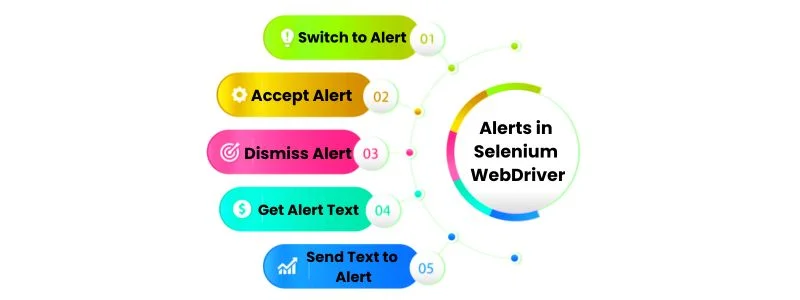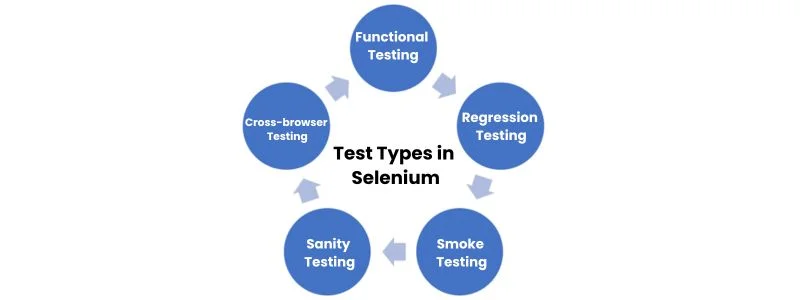Selenium is a widely used open-source tool for automating web browsers. It enables web application testers to create scripts in several programming languages and test web apps to make sure they work properly on numerous platforms and browsers. Interview preparation can be challenging, especially if you’re a fresher in the automation testing world.
If you aim to ace your next interview, having a solid grasp of Selenium can set you apart. To help you get started, Freshers Job came up with a list of the top 50 Selenium Interview Questions and Answers for Freshers to confidently tackle your interview and showcase your expertise in Selenium.
Selenium Interview Questions and Answers
Let’s explore the Selenium Interview Questions and the answers to guide you to attend your interview easily and confidently.
Selenium Interview Questions
- What is Selenium?
Selenium is a well-liked open-source program for automating web browsers. It allows programmers to create scripts in multiple languages, including Java, Python, and C#, to test web applications and ensure they perform properly on various systems and browsers.
- What are the components of Selenium?
Selenium consists of four main components:
- Selenium IDE: A record and playback tool.
- Selenium WebDriver: A programming interface for creating and executing test cases.
- Selenium Grid: Allows running tests on different machines and browsers simultaneously.
- Selenium RC (Remote Control): Now deprecated, it was used to execute scripts in different browsers.
- What is Selenium WebDriver?
Selenium WebDriver is a key component of Selenium, which lets you build reliable, browser-based regression automation suites and tests. It offers a programming interface for interacting with online elements and works with several browsers, including Firefox, Safari, and Chrome.
- How do you locate web elements in Selenium?
Web elements in Selenium can be located using various strategies such as:
- ID: driver.findElement(By.id(“exampleId”))
- Name: driver.findElement(By.name(“exampleName”))
- Class Name: driver.findElement(By.className(“exampleClass”))
- Tag Name: driver.findElement(By.tagName(“exampleTag”))
- Link Text: driver.findElement(By.linkText(“exampleLink”))
- Partial Link Text: driver.findElement(By.partialLinkText(“examplePartialLink”))
- CSS Selector: driver.findElement(By.cssSelector(“exampleCSS”))
- XPath: driver.findElement(By.xpath(“exampleXPath”))
- What is the difference between findElement and findElements in Selenium?
| findElement | findElements |
| findElement is used to find a single web element, returning the first match. | findElements returns a list of all the matching elements. If no elements are found, findElement throws an exception, while findElements returns an empty list. |
Intermediate Selenium Questions and Answers
- What are the types of waits available in Selenium WebDriver?
Selenium WebDriver provides three types of waits:
- Implicit Wait: Sets a default wait time for the entire test duration.
- Explicit Wait: Holds off until a specific condition occurs.
- Fluent Wait: Similar to Explicit Wait but allows setting the polling frequency and ignoring specific exceptions.
- How to handle frames in Selenium WebDriver?
To handle frames in Selenium WebDriver, you can switch to a frame using:
- By Index: driver.switchTo().frame(index)
- By Name or ID: driver.switchTo().frame(“frameNameOrId”)
- By Web Element: driver.switchTo().frame(element)
To switch back to the default content, use driver.switchTo().defaultContent().
- What is a headless browser, and how is it useful in Selenium?
A headless browser is an online browser that does not have a graphical user interface. It is useful in Selenium for executing tests faster and in environments where a GUI is not required, such as CI/CD pipelines. Examples include Headless Chrome and Headless Firefox.
- How to handle alerts and pop-ups in Selenium WebDriver?
Alerts and pop-ups in Selenium WebDriver can be handled using the Alert interface:
- Switch to Alert: Alert alert = driver.switchTo().alert()
- Accept Alert: alert.accept()
- Dismiss Alert: alert.dismiss()
- Get Alert Text: String alertText = alert.getText()
- Send Text to Alert: alert.sendKeys(“exampleText”)
- What are implicit waits in Selenium WebDriver?
When an element isn’t immediately available, implicit waits tell the WebDriver to hold off on throwing an exception for a predetermined period of time. It is applied to all ensuing findElement() calls after being set once.
Selenium Automation Framework Interview Questions And Answers
- What is a Selenium automation framework?
A Selenium automation framework is a structured set of guidelines, practices, and tools used to automate the testing of web applications. It standardizes how tests are written, executed, and maintained, promoting reusability, scalability, and efficiency in the testing process.
- What are the different types of automation frameworks in Selenium
There are several types of automation frameworks in Selenium, including:
- Data-Driven Framework: Uses external data sources (e.g., Excel, CSV) to drive test cases.
- Keyword-Driven Framework: Uses predefined keywords to represent actions performed on the application.
- Hybrid Framework: Combines features of both data-driven and keyword-driven frameworks.
- Page Object Model (POM): Uses classes to represent web pages and encapsulate elements and actions.
- What is the Page Object Model (POM) in Selenium?
The Page Object Model (POM), a Selenium design pattern, promotes the creation of an object repository for web things. Eliminating code duplication and improving test maintenance are achieved by creating a unique class that encompasses all the components and functions of every webpage.
- How do you manage test data in a data-driven framework?
In a data-driven framework, test data is managed externally in Excel spreadsheets, CSV files, or databases. Test scripts are designed to read data from these sources, allowing for easy updates and running tests with multiple data sets without changing the test logic.
- What is a TestNG framework, and how is it used in Selenium?
TestNG is a testing framework created specifically for Java testing requirements, modeled after JUnit and NUnit. In Selenium, TestNG is used for:
- Organizing and managing test cases.
- Executing test cases in parallel.
- Generating detailed reports.
- Managing test configuration and setup through annotations like @BeforeTest, @AfterTest, @Test, etc.
Intermediate level Selenium Automation Framework Interview Questions And Answers
- How do you handle exceptions in a Selenium automation framework
Exception handling in a Selenium automation framework can be managed using try-catch blocks to catch and handle exceptions gracefully. Additionally, frameworks often include custom exception classes and utility methods to log errors and take screenshots of failure, ensuring robust error handling and reporting.
- What is the role of a build tool in a Selenium automation framework
Build tools like Maven or Gradle to manage project dependencies, compile source code, and execute test cases. They streamline the build process, ensure consistency across environments, and integrate with continuous integration (CI) tools like Jenkins for automated testing and deployment.
- How do you integrate Selenium with a continuous integration (CI) tool?
To integrate Selenium with a CI tool like Jenkins:
- Install the necessary plugins (e.g., Maven, TestNG).
- Create and configure a job to build the project and execute tests.
- Set up triggers for automatic test execution (e.g., on code commits).
- Use plugins for test result reporting and notifications.
- How do you maintain cross-browser testing in a Selenium framework?
Cross-browser testing in a Selenium framework uses WebDriver to instantiate different browser drivers (e.g., ChromeDriver, FirefoxDriver). Test configurations are managed through properties files or test configuration classes, enabling tests to run on multiple browsers by setting browser-specific parameters.
- What is the significance of logging in a Selenium automation framework?
Logging in a Selenium automation framework provides insights into the execution flow and helps diagnose issues. Log4j or SLF4J are commonly used to log information at different levels (e.g., info, debug, error). Logging facilitates debugging, monitoring test execution, and generating reports for better test management.
Selenium Webdriver Interview Questions And Answers
- How do you start a browser session in Selenium WebDriver?
To start a browser session, you need to create an instance of the WebDriver interface for the desired browser.
For example, for Chrome:
WebDriver driver = new ChromeDriver();
- What are the different locators used in Selenium WebDriver?
Selenium WebDriver supports various locators to identify web elements, such as ID, name, XPath, CSS selector, class name, and tag name.
- How do you handle dynamic elements in Selenium WebDriver?
Explicit waits, which are supplied by WebDriverWait, can be used to manage dynamic items. This ensures that the script waits until the element is visible or clickable before performing actions.
- What is the purpose of the Actions class in Selenium WebDriver?
The Actions class in Selenium WebDriver performs complex user interactions such as mouse hover, drag-and-drop, double-click, and context-click (right-click) actions.
- How do you handle dropdowns in Selenium WebDriver?
To handle dropdowns in Selenium WebDriver, import the Select class, locate the dropdown element, create a Select object with this element, and use methods like ‘selectByVisibleText’, ‘selectByValue, or ‘selectByIndex’ to select options. For multi-select dropdowns, use deselect methods as needed.
Intermediate Selenium Webdriver Interview Questions And Answers
- What are some common challenges faced while using Selenium WebDriver?
Some common challenges include handling dynamic elements, dealing with browser compatibility issues, setting up effective waits, and maintaining test scripts as applications evolve. It takes a solid grasp of Selenium WebDriver’s functionality and test automation best practices to overcome these obstacles.
- How to handle browser navigation in Selenium WebDriver?
In Selenium WebDriver, you can handle browser navigation using methods like navigate().to(url) to navigate to a specific URL, navigate().back() to go back, navigate().forward() to go forward, and navigate().refresh() to refresh the current page. These methods help manage browser history seamlessly during automated testing.
- How do you perform keyboard actions in Selenium WebDriver?
Keyboard actions can be performed using the sendKeys() method of the WebElement interface to simulate typing text into input fields or pressing keys like Enter or Tab.
- How do you handle multiple windows or tabs in Selenium WebDriver?
You can handle multiple windows or tabs using methods like getWindowHandles() to get handles of all open windows and switchTo().window() to switch between them.
- How do you capture screenshots in Selenium WebDriver?
Screenshots can be captured using the TakesScreenshot interface, which allows you to take a screenshot of the current browser window and save it as a file.
Test-Automation related Selenium Interview Questions With Answers
- How do you handle file uploads in Selenium?
Using the sendKeys() method, you may send the file path to the file input element in Selenium to manage file uploads.
Syntax:
WebElement uploadElement = driver.findElement(By.id(“upload”));
uploadElement.sendKeys(“C:/path/to/file.txt”);
- How can you perform mouse hover actions in Selenium WebDriver?
Mouse hover actions are a function of the Actions class:
Syntax:
Actions actions = new Actions(driver);
WebElement element = driver.findElement(By.id(“elementID”));
actions.moveToElement(element).perform();
- What is the Page Factory in Selenium?
Page Factory is a Selenium class that supports the Page Object Model. It provides an optimized way to create and initialize page objects.
For example:
public class LoginPage {
@FindBy(id = “username”)
WebElement username;
@FindBy(id = “password”)
WebElement password;
public LoginPage(WebDriver driver) {
PageFactory.initElements(driver, this);
}
}
- How do you manage cookies in Selenium WebDriver?
Cookies can be managed using methods like addCookie(), getCookieNamed(), deleteCookie(), and deleteAllCookies().
For example:
Cookie cookie = new Cookie(“key”, “value”);
driver.manage().addCookie(cookie);
Cookie retrievedCookie = driver.manage().getCookieNamed(“key”);
driver.manage().deleteCookie(cookie);
driver.manage().deleteAllCookies();
- Explain the difference between driver.close() and driver.quit().
| driver.close() | driver.quit() |
| Closes the browser window that is now the WebDriver’s active focus. | Closes all browser windows opened by the WebDriver and ends the session. |
Intermediate Test-Automation-related Selenium Interview Questions With Answers
- How can you execute JavaScript in Selenium?
JavaScript can be executed using the JavascriptExecutor interface.
Syntax:
JavascriptExecutor js = (JavascriptExecutor) driver;
js.executeScript(“alert(‘Hello World’);”);
- How do you switch between frames in Selenium?
You can switch between frames using switchTo().frame() method.
Syntax:
driver.switchTo().frame(“frameName”);
driver.switchTo().defaultContent(); // Switch back to the main content
- What is TestNG, and how is it used with Selenium?
A testing framework called TestNG was inspired by JUnit and NUnit. It is designed for test configuration and execution and provides annotations, grouping, and parallel execution support. It is used with Selenium to structure and manage test cases efficiently.
- What is a Selenium Grid?
Selenium Grid is a tool in Selenium that allows simultaneous execution of tests on multiple browsers, operating systems, and devices. It facilitates parallel testing, improves test efficiency, and reduces execution time by distributing test cases across a network of machines called nodes, managed by a central hub.
- How do you handle dynamic web elements in Selenium?
Dynamic elements can be handled using dynamic locators (like XPath with contains or starts-with functions) and explicit waits.
Syntax:
WebDriverWait wait = new WebDriverWait(driver, 10);
WebElement element = wait.until(ExpectedConditions.visibilityOfElementLocated(By.xpath(“//div[contains(@id, ‘dynamic’)]”)));
Frequently Asked Selenium Questions and Answers
- Define Selenium testing.
Selenium testing refers to the use of the Selenium tool suite to automate the testing of web applications. It enables testers to create scripts that simulate user interactions with web elements, such as clicking buttons, entering text, and navigating through pages. Selenium testing helps ensure that web applications function as expected across different browsers and platforms by automating repetitive tasks and allowing for more comprehensive test coverage.
- What distinguishes Selenium 3.0 from Selenium 2.0? If so, how?
Selenium 3.0 introduced several enhancements over Selenium 2.0, focusing primarily on stability and support for modern web browsers. Key distinctions include:
- Deprecation of Selenium RC: To encourage users to move to WebDriver, Selenium 3.0 formally deprecated Selenium Remote Control (RC).
- Improved WebDriver: WebDriver APIs have been improved to handle the most recent browser versions and provide greater browser automation.
- W3C WebDriver Protocol: By implementing the W3C WebDriver standard, Selenium 3.0 enhanced browser interoperability and minimized browser-specific code.
- Backward Compatibility: Maintaining backward compatibility with Selenium 2.0 made it simpler for users to update without making major adjustments to their current scripts.
- List a few of the popular automation testing tools.
Some of the popular automation testing tools include:
- Selenium: For web application testing.
- QTP/UFT (Unified Functional Testing): For functional and regression testing.
- Appium: For mobile application testing on iOS and Android platforms.
- TestComplete: For desktop, mobile, and web application testing.
- Cucumber: For behavior-driven development (BDD) testing.
- JMeter: For performance and load testing.
- Define a locator.
In Selenium, a locator is a tool for locating and interacting with web items on a webpage. Locators are essential for creating accurate and reliable test scripts, enabling Selenium to find and perform actions on specific elements. Common locators include ID, Name, Class Name, Tag Name, Link Text, Partial Link Text, CSS Selector, and XPath.
- Which test types does Selenium support?
Selenium supports various types of testing, including:
- Functional Testing: Verifies that the application operates in accordance with the requirements by observing how it should.
- Regression Testing: Ensures that recent code changes have not adversely affected existing functionality.
- Smoke Testing: Quickly checks the basic functionalities of an application to ensure they work correctly.
- Sanity Testing: Focuses on specific components or features of an application after minor changes.
- Cross-browser Testing: Validates that the application works consistently across different web browsers.
- Describe XPath.
A query language called XPath (XML Path Language) is used to move between elements and attributes within an XML document. By constructing a path expression, XPath is utilized in the Selenium environment to locate elements on a web page. XPath can be very powerful and flexible, allowing testers to create complex queries to identify elements based on their attributes, text content, hierarchical position, etc.
- Describe the distinction between an XPath single and double slash.
| Single Slash (/) | Double Slash (//) |
| This represents an absolute path. It selects elements starting from the root of the document.
For example, /html/body/div selects the div element that is a direct child of the body element, which is, in turn, a direct child of the HTML root. |
Represents a relative path. It selects elements anywhere in the document, regardless of their location in the hierarchy.
For example, //div selects all div elements throughout the document. |
- What makes Selenium a good choice for test automation?
Selenium is a popular choice for test automation due to several key factors:
- Open Source: Free to use with no licensing costs.
- Multi-Browser Support: Works with all major web browsers, including Chrome, Firefox, Safari, and Edge.
- Cross-Platform: Supports various operating systems like Windows, macOS, and Linux.
- Language Support: Programming languages like Java, C#, Python, Ruby, and JavaScript are among those with which it is compatible.
- Integration: Easily integrates with tools and frameworks like TestNG, JUnit, Maven, Jenkins, and more.
- Community and Documentation: Strong community support and comprehensive documentation make finding solutions and best practices easier.
- Are there any technical limitations on Selenium? If so, what limitations apply?
Yes, Selenium has some technical limitations, including:
- Browser Dependency: Requires a browser to execute tests, making it unsuitable for non-web applications.
- No Built-in Reporting: Lacks built-in reporting features; additional tools or frameworks are needed for generating test reports.
- Limited Support for Image Testing: It does not natively support image-based testing or verifying the visual aspects of a web page.
- Handling of Dynamic Elements: Interacting with highly dynamic web elements can be challenging, requiring advanced techniques like explicit waits and custom locators.
- Steep Learning Curve: This course requires knowledge of programming and web technologies, which can be a barrier for non-technical users.
- Define an object repository.
An object repository is a centralized location where information about web elements is stored. It allows testers to manage and organize locators for the web elements used in their test scripts. By using an object repository, changes to the web elements (such as attribute values or identifiers) can be managed more efficiently, as updates need to be made only in one place rather than in multiple test scripts. This enhances the maintainability and scalability of test automation projects.
Career Prospects
Selenium is an open-source program compatible with all browsers and operating systems. It is also capable of integrating with several frameworks. As to the research published recently, Microsoft, Cognizant, HP, Facebook, Capgemini, Oracle, and Accenture are among the esteemed companies that employ Selenium testers. Additionally, Selenium Tester, Selenium Automation Engineer, Selenium Automation Analyst, Java Selenium Automation Engineer, Mobile Testing Lead, QA Engineer, Senior QA Automation Engineer, and Automation Test Lead are among the typical job titles offered to candidates with experience with the Selenium tool.
In India, the salary range for an entry-level Selenium Automation Tester is between Rs. 4,20,000 and Rs. 5,30,000. Experienced testers make between Rs. 5,45,000 and Rs. 7,20,000 annually, while senior level applicants make between Rs. 7,30,000 and Rs. 9,75,000 annually. A Selenium Tester makes $94,000 worldwide.
Selenium’s many features and options for testers make it a top tool in the testing business. First and foremost, we consider the programming languages a tool supports when selecting one. The tester can write the program in any programming language, and Selenium will convert it to codes that are compatible with Selenium right away. Let’s discuss the career opportunities offered in the Selenium field. Selenium offers testers many options, mostly supporting major programming languages like Java, Python, C, C++, Ruby, and Perl. The tester can write the program in any programming language, and Selenium will convert it to codes that are compatible with Selenium right away. Let’s discuss the career opportunities offered in the Selenium field. Take a look at the Top 10 Selenium Institutes in Chennai to identify the best fit for improving your skills.
QA/Testing Intern
As a QA/Testing Intern, you will start your journey in the Selenium field by assisting senior QA engineers with writing and executing test scripts. You’ll learn the basics of test automation, become familiar with Selenium WebDriver, and gain an understanding of the software development lifecycle. This role requires basic programming knowledge and a foundational grasp of software testing principles.
Junior Test Automation Engineer
In this job role, you will write and maintain automated test scripts under supervision, execute test cases, and document results. You’ll begin working with test frameworks and tools, building on your basic programming skills and knowledge of Selenium WebDriver.
Test Automation Engineer
A Test Automation Engineer will develop, maintain, and enhance automated test scripts. Your responsibilities will include integration tests with CI/CD pipelines and collaborating with development teams to identify and resolve issues. Advanced knowledge of Selenium WebDriver, experience with test automation frameworks like TestNG or JUnit, and proficiency in version control systems are essential for this role.
QA Analyst
In this position, you will design and execute automated and manual tests, analyze test results, and report defects. You’ll contribute to test strategy and planning, requiring strong analytical skills, experience with test management tools, and a solid understanding of software development and testing methodologies.
Senior Test Automation Engineer
As a senior engineer, you will lead automation projects, mentor junior engineers, develop complex test scripts, and optimize test automation strategies. This role demands expertise in Selenium, a deep understanding of test automation frameworks, experience with performance and load testing, and strong programming skills.
QA Lead/Manager
QA Leads and Managers oversee QA teams, define testing strategies, ensure quality standards are met, and manage test resources and schedules. They communicate with stakeholders to align testing efforts with business goals. This role requires leadership and project management skills, extensive experience in test automation and manual testing, strategic planning abilities, and excellent communication skills.
Test Architect
- Test Architects design and implement the overall test automation architecture.
- Evaluate new tools and technologies.
- Set standards and best practices for test automation across the organization.
This role requires deep expertise in test automation, strong architectural skills, experience with various testing tools and technologies, and the ability to drive innovation in testing.
Director of QA/Quality Engineering
Directors lead the entire QA department, define the vision and strategy for quality assurance, manage budgets, and ensure alignment of QA efforts with the company’s objectives. Extensive leadership experience, strong strategic and operational management skills, a deep understanding of QA processes and methodologies, and a track record of driving quality improvements are essential.
Vice President (VP) of Quality Assurance
VPs oversee all quality assurance activities within the organization, drive high-level strategic initiatives, and ensure the highest quality standards across all products and services. Proven leadership in QA, strategic vision, ability to influence and drive organizational change, and exceptional knowledge of industry standards and practices are required for this top-tier position.
Performance Test Engineer
These engineers focus on performance testing to ensure applications meet performance criteria under various conditions. They use tools like JMeter in conjunction with Selenium, requiring knowledge of performance testing tools, scripting, and performance tuning skills.
Security Test Engineer
Security Test Engineers perform security testing to identify application vulnerabilities, using Selenium to automate security checks. This role demands understanding security testing methodologies, familiarity with security tools, and scripting knowledge. Are you looking for Fresher Jobs in Coimbatore? Explore various job opportunities in the region.
DevOps Test Engineer
DevOps Test Engineers integrate automated testing into CI/CD pipelines, ensuring smooth and rapid deployment cycles. This role requires a blend of test automation skills and a deep understanding of DevOps practices, enabling seamless integration and deployment processes.
Selenium is a powerful tool that has become essential in test automation. For freshers, gaining proficiency in Selenium can significantly boost your career prospects in software testing and quality assurance. By studying and mastering the basics of Selenium, you establish the foundation for a successful journey in test automation. This blog has covered the key Selenium Interview Questions and Answers for beginners. As you prepare for your interviews, focus on these core concepts, practice regularly, and explore additional resources to deepen your knowledge.











